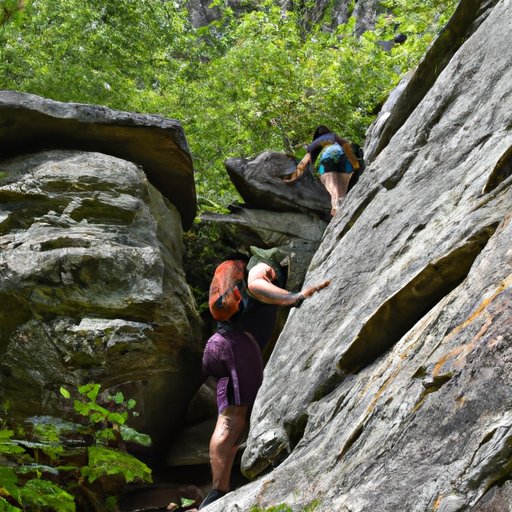Introduction
Scrambling is a popular activity among hikers and rock climbers that involves navigating difficult terrain and often requires a combination of hiking and climbing. Scrambling can be physically demanding, but it also offers a unique opportunity to explore the outdoors and experience new thrills. In this article, we’ll explore what scrambling is, the basics of how to get started, and some of the safety considerations and techniques for experienced scramblers.
A Beginner’s Guide to Scrambling
Before you head out on your first scramble, there are a few things you need to know about hiking and climbing. First, you should familiarize yourself with the terrain you plan to traverse. Make sure you know what type of rocks and vegetation you will encounter on your route. You should also understand the risks associated with scrambling, such as falling rocks or loose footing.
When it comes to equipment, you’ll need sturdy boots, comfortable clothing, and appropriate supplies for the weather conditions. It’s also important to bring plenty of water, snacks, and a first-aid kit in case of emergencies. For more challenging scrambles, you may want to consider bringing along a rope, harness, and other climbing gear.
There are different types of scrambling depending on the difficulty level. Easy scrambles involve walking up steep hills or over rocky surfaces, while more difficult scrambles require technical skills such as belaying and rappelling. Before attempting a more advanced scramble, it’s important to make sure you have the necessary experience and training.

Exploring the Thrills of Scrambling
If you’re new to scrambling, it’s best to start off with a basic hike and work your way up. This will help you get used to the terrain and learn how to move safely over it. As you become more comfortable, you can gradually add more challenging elements, such as rock climbing and belaying. When exploring a new area, it’s always best to go with an experienced guide who can show you the safest routes and provide helpful tips.
Safety is always the top priority when scrambling. Be sure to wear a helmet and carry a first-aid kit with you at all times. Make sure you’re aware of your surroundings and pay close attention to potential hazards. If you’re ever unsure of a route or feel uncomfortable, it’s best to turn back.
Scrambling Up the Mountain
As you gain more experience, you can tackle more challenging scrambles. Experienced hikers should have a good understanding of the terrain and be able to read the landscape to identify potential hazards. Be sure to practice proper technique when crossing difficult sections, such as using your hands and feet to maintain balance and keeping your center of gravity low.
It’s also important to be aware of different types of terrain. Loose rocks and scree can be dangerous, so take extra caution when navigating these areas. Snow and ice can also present challenges, so make sure you’re prepared with the right equipment and know how to use it.
The Adventure of Scrambling
For those looking for a real thrill, scrambling can offer an exciting way to explore the outdoors. To safely tackle challenging trails, you’ll need to develop a few key skills. Belaying, for example, is a technique for securing a climber to a fixed anchor point. Rappelling is another useful technique for descending from a high point by sliding down a rope. Both of these skills require practice and instruction from an experienced climber.
When attempting a difficult scramble, it’s also important to be mindful of your body. Listen to your body and take breaks when needed. If you’re ever feeling too tired or unsure of a route, it’s best to turn back and wait until you’re feeling better.
Making the Most Out of Your Hike with Scrambling
Scrambling can be a great way to explore the outdoors and add a new layer of adventure to your hikes. With the right knowledge and preparation, you can safely navigate even the most challenging trails. Make sure you’re familiar with the basics of hiking and climbing, and understand the risks associated with scrambling. Have the right equipment, practice proper technique, and be aware of your surroundings. And don’t forget to have fun!
Conclusion
Scrambling is a thrilling way to explore the outdoors. It can be physically demanding, but with the right preparation and technique, you can safely tackle even the most challenging trails. Understanding the basics of hiking and climbing, having the right equipment, and being mindful of your body are essential for safe scrambling. So, get out there and enjoy the adventure!


